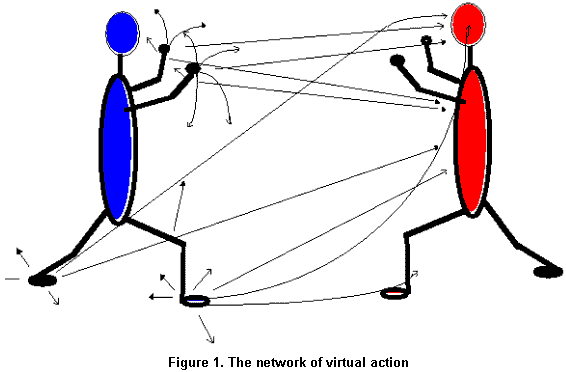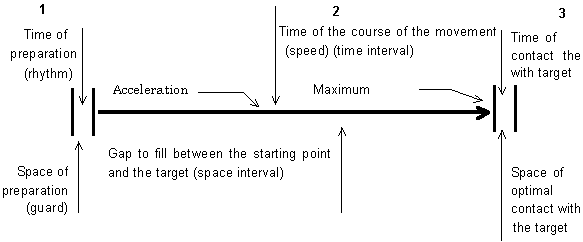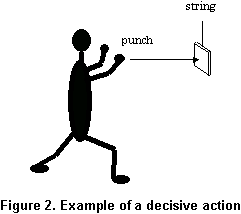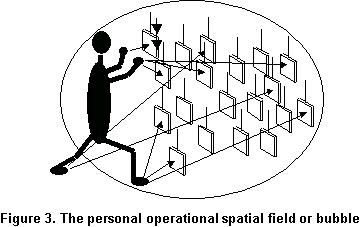DO (WAY) as a field of research in Human-development.
The Japanese word Do (Way, Road or Method) refers to the developmental path followed by the practitioners of a discipline: for example, kado or the Way of flower arrangement, shodo or the Way of calligraphy, Kyudo or the way of archery, budo or the Way of martial arts. Do implies that the purpose of a practice is not the mastery of the discipline itself. The discipline constitutes a mean, method or way for self-perfection and for achieving a harmonious relationship with the environment and people.
For example, learning and teaching of karate-do (or dance, poetry, music, etc.) is more than an "assemblage of mere techniques of fighting" (Fr d
d ric, 1995, p. 26).
ric, 1995, p. 26).
Most interesting thing about a discipline constituting a do is that the highest stages of development are attained only at relative old age and, in a deeper sense, only by few people (contrary to the practice of a discipline solely for the purpose of mastering it). Indeed an "old" master of karate with decreased physical skills is able to defeat a young, strong and well-trained adversary.
We study Self-development in the particular domain of karatedo for three reasons:
Developing as relating: the construction of an ever better relation with "Other"
We propose a three steps developmental model of the evolution of the relation with "Other". The genesis of this relationship, which appears to be a symbiotic one at the start (fusion of the S with the O), is progressively transformed in a relation of exteriority (separation of the S from the O) and becomes, at the highest level, a relation of interiority (union or S-O oneness) (Masciotra, 1996)
Differences with current developmental theories:
Relating as a dance with "Other"
Space, time and rhythm pervade all arts and the entire human life (Dewey, 1958). "No form of life evolved or could evolve in a timeless nonrhythmic world" (Hall, 1989, p.16) nor in a spaceless world. The way people - and cultures - develop as a great deal to do with how they adaptively relate to the world and get in tune with each other. They do so, via living and nonverbal acts such as spacing, distancing, syncing, timing, breathing... People grows by <dancing>or <juggling> with the world and progress knowingly-and-feelingly toward an ever better harmony.
While, in everyday life, such culturally embedded acts are performed, read and sensed with great immediacy, they are more available to consciousness, explicit and strategically performed in domains like arts and sports. We study the art of distancing, -the purpose of any act of distancing being to strategically control both space and time in humans hic et nunc relationships - in martial arts.
Distancing is related to the Japanese notion of <maai>: ma means the spatial and temporal interval that separates two or more objects or persons, while ai refers to the encounter between objects and or persons (Tokitsu, 1979).
Distancing implies a network of virtual actions

The guard is a mental attitude or a body minded positioning; it is not just a corporeal posture (the body is minded in the sense that it makes available simultaneously several possible actions). Scenario: the right fist is ready to execute (at any time and at any place) multiple offensive or defensive actions (arrows in figure). Fists, legs, knees, elbows, and other parts of the guard are ready to execute a set of actions. The guard is a system of virtual actions.
The minded guard is the locus of cohabitation of virtual actions and constitutes the structure that unifies them timelessly. Scenario: the legs and the fists, for example, can discharge instantaneously from the guard like the 100 kilometers from the starting blocks.
The virtual actions are not in the head of the combatant but embodied in the structure of the guard.


Distancing is syncing
Syncing is harmonizing space and time intervals within Self and with the "Other". The control of rhythm is very important in determining when and where it is a appropriate to hit or block.
The master of karate is able to assimilate the opponent's rhythm and to accommodate to it without having to modify his own rhythm or guard.
To assimilate = to grasp (understand-in-action) the opponent's rhythm through one's own rhythm, body vibrations.
To accommodate = to tune with the opponent's rhythm and to size, with the proper timing, the opportunities of action that it offers.
Understanding-in-action the opponent's rhythm allows to be aware of short phases of the rhythm and to "catch" (identify) in which phase an attack may start: that enables the master to be ahead and to establish a favorable balance of power.
Figure 5 illustrates two rhythms: rhythm A is slow; rhythm B is fast. Dashes indicate time when one cannot release an action and dots indicate moments when releasing is possible. The karateka displaying rhythm B will have a clear advantage over his opponent (with rhythm A). With such an advantage, one gets continuously ahead of the opponent's action. Getting ahead is more than anticipating: it is forestalling eminent events, being provided against opponent's intentions and so outdistancing him all the way. For ex., by means of rhythm B, the karateka can deliver an attack at the moment when (as pictured by the arrow in figure 5) it becomes easy to catch out the opponent, because, this last, being on the dash time, will be caught off-beat and, so, won't be able to react in time.

---------------------------------------------------------------
Ackermann, Edith (1996). Perspective-taking and Object Construction: Two Keys to Learning. In Kafai, Y. & Resnick, M. (Eds) Constructionism in Practice: Designing, Thinking, and Learning in a Digital World. Lawrence Erblaum Associated. pp. 25-35.
Masciotra, Domenico (1996). La gen se de la relation
se de la relation  l'Autre: de la symbiose
l'Autre: de la symbiose  l'ext
l'ext riorit
riorit et
et  l'int
l'int riorit
riorit . Archives de Psychologie, 64, 207-225.
. Archives de Psychologie, 64, 207-225.
Masciotra, Domenico (1996). Le <savoir-penser-en-acte>: une finalit de l'
de l' ducation physique. In Dossier EP.S #29,
ducation physique. In Dossier EP.S #29,  ditions Revue EP.S. 1996, pp 172-179).
ditions Revue EP.S. 1996, pp 172-179).
Fr d
d ric, Louis. (1995) A Dictionary of the Martial Arts. Charles E. Tuttle
ric, Louis. (1995) A Dictionary of the Martial Arts. Charles E. Tuttle  .
.
---------------------------------------------------------------
Domenico Masciotra, Edith Ackermann, To Know is to Relate: The Art of Distancing in Human Transactions, 1997. Retrieved June 2, from the World Wide Web
http://www.er.uqam.ca/nobel/k32277/Know.relate.conference.htm
The Japanese word Do (Way, Road or Method) refers to the developmental path followed by the practitioners of a discipline: for example, kado or the Way of flower arrangement, shodo or the Way of calligraphy, Kyudo or the way of archery, budo or the Way of martial arts. Do implies that the purpose of a practice is not the mastery of the discipline itself. The discipline constitutes a mean, method or way for self-perfection and for achieving a harmonious relationship with the environment and people.
For example, learning and teaching of karate-do (or dance, poetry, music, etc.) is more than an "assemblage of mere techniques of fighting" (Fr
Most interesting thing about a discipline constituting a do is that the highest stages of development are attained only at relative old age and, in a deeper sense, only by few people (contrary to the practice of a discipline solely for the purpose of mastering it). Indeed an "old" master of karate with decreased physical skills is able to defeat a young, strong and well-trained adversary.
We study Self-development in the particular domain of karatedo for three reasons:
- karate can be learned, practiced, taught and studied as a do;
- karate-do is practiced by some individuals all-life long and sometimes in the same Dojo (training hall), with the same master and even with the same partners: this favors the continuous (longitudinal and transversal) observations of the evolution the relationships with others.
- one of us is an expert in karate-do
Developing as relating: the construction of an ever better relation with "Other"
We propose a three steps developmental model of the evolution of the relation with "Other". The genesis of this relationship, which appears to be a symbiotic one at the start (fusion of the S with the O), is progressively transformed in a relation of exteriority (separation of the S from the O) and becomes, at the highest level, a relation of interiority (union or S-O oneness) (Masciotra, 1996)
| Symbiosis (Fusion) S-O |
Exteriority (Separation) S-O |
Interiority (Union) (S-O) |
| Being indistinctly one's actions; the Other is an undifferentiated part of self-being. | Having actions and the Other has its own actions. | Oneness: Self and Other are one body action; the Other is self-prolongation. |
| Intra-being (adualistic): Subject is indivisibly immersed in the world. | Inter-being (dualistic): Subject has the world at hand and exchanges with it. | Trans-being (holistic): Subject harmoniously unifies with the world. |
| Egocentricity | Reciprocity | Entirety |
| Participation | Interaction | Communion |
| Reactivity | Action/reaction | Partaking |
Differences with current developmental theories:
- Developmental theories generally emphasize human self growth rather than the construction of alterity. While self growth researches give an account concentrated on the subject side, a study of the construction of alterity implies to consider indivisibly the subject-and-the-object and to stress on their rapport.
- Developmental theories generally see development as a process of separation of the S with the O. The more one removes oneself out of context, the better he or she can think about it and elaborate strategies to deal with it. On the contrary, the emphasis on the S-O situated cohabitation means that knowing, in regard to the expert action of practitioners, does not consist to withdraw oneself from the world (the world has no exit), but more to relate to it here and now, to tune with it, to dwell, grow and expand in it more and more adaptively (Ackermann, 1996).
- Only the third developmental step is presented in this poster.
Relating as a dance with "Other"
Space, time and rhythm pervade all arts and the entire human life (Dewey, 1958). "No form of life evolved or could evolve in a timeless nonrhythmic world" (Hall, 1989, p.16) nor in a spaceless world. The way people - and cultures - develop as a great deal to do with how they adaptively relate to the world and get in tune with each other. They do so, via living and nonverbal acts such as spacing, distancing, syncing, timing, breathing... People grows by <dancing>or <juggling> with the world and progress knowingly-and-feelingly toward an ever better harmony.
While, in everyday life, such culturally embedded acts are performed, read and sensed with great immediacy, they are more available to consciousness, explicit and strategically performed in domains like arts and sports. We study the art of distancing, -the purpose of any act of distancing being to strategically control both space and time in humans hic et nunc relationships - in martial arts.
Distancing is related to the Japanese notion of <maai>: ma means the spatial and temporal interval that separates two or more objects or persons, while ai refers to the encounter between objects and or persons (Tokitsu, 1979).
Distancing implies a network of virtual actions

The minded guard is the locus of cohabitation of virtual actions and constitutes the structure that unifies them timelessly. Scenario: the legs and the fists, for example, can discharge instantaneously from the guard like the 100 kilometers from the starting blocks.
The virtual actions are not in the head of the combatant but embodied in the structure of the guard.
 |
The punch constitute a decisive action if it can brake the board. To put an opponent at distance, one must be able of at least one decisive action. |
 |
|
-
All the places where the wooden board can be broken. The wooden boards represent the places where the adversary could eventually be hit.
- Each arrow represents a virtual distance. Distance is the spatial interval between a part of the body (fist, foot) and a wooden board.
- Distancing means using simultaneously all the virtual distances (arrows) and performing the proper action for the proper distance whenever needed.
- Defensive actions are not represented in the figure, though they are part of the guard.

Distancing is syncing
Syncing is harmonizing space and time intervals within Self and with the "Other". The control of rhythm is very important in determining when and where it is a appropriate to hit or block.
The master of karate is able to assimilate the opponent's rhythm and to accommodate to it without having to modify his own rhythm or guard.
To assimilate = to grasp (understand-in-action) the opponent's rhythm through one's own rhythm, body vibrations.
To accommodate = to tune with the opponent's rhythm and to size, with the proper timing, the opportunities of action that it offers.
Understanding-in-action the opponent's rhythm allows to be aware of short phases of the rhythm and to "catch" (identify) in which phase an attack may start: that enables the master to be ahead and to establish a favorable balance of power.
Figure 5 illustrates two rhythms: rhythm A is slow; rhythm B is fast. Dashes indicate time when one cannot release an action and dots indicate moments when releasing is possible. The karateka displaying rhythm B will have a clear advantage over his opponent (with rhythm A). With such an advantage, one gets continuously ahead of the opponent's action. Getting ahead is more than anticipating: it is forestalling eminent events, being provided against opponent's intentions and so outdistancing him all the way. For ex., by means of rhythm B, the karateka can deliver an attack at the moment when (as pictured by the arrow in figure 5) it becomes easy to catch out the opponent, because, this last, being on the dash time, will be caught off-beat and, so, won't be able to react in time.

---------------------------------------------------------------
Ackermann, Edith (1996). Perspective-taking and Object Construction: Two Keys to Learning. In Kafai, Y. & Resnick, M. (Eds) Constructionism in Practice: Designing, Thinking, and Learning in a Digital World. Lawrence Erblaum Associated. pp. 25-35.
Masciotra, Domenico (1996). La gen
Masciotra, Domenico (1996). Le <savoir-penser-en-acte>: une finalit
Fr
---------------------------------------------------------------
Domenico Masciotra, Edith Ackermann, To Know is to Relate: The Art of Distancing in Human Transactions, 1997. Retrieved June 2, from the World Wide Web
http://www.er.uqam.ca/nobel/k32277/Know.relate.conference.htm














